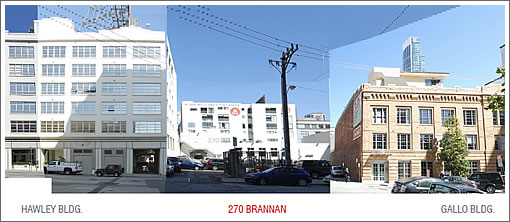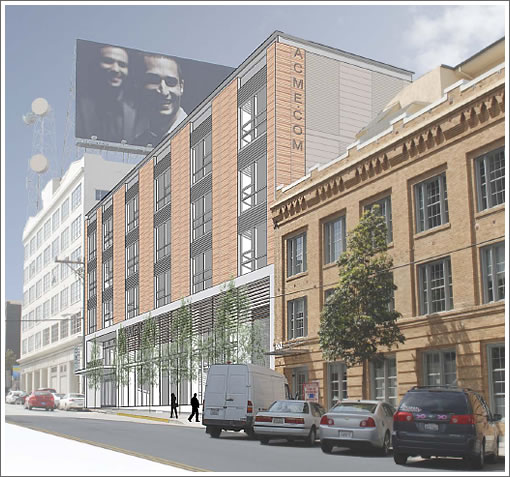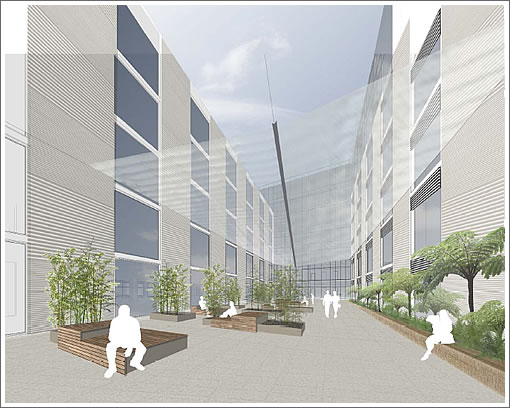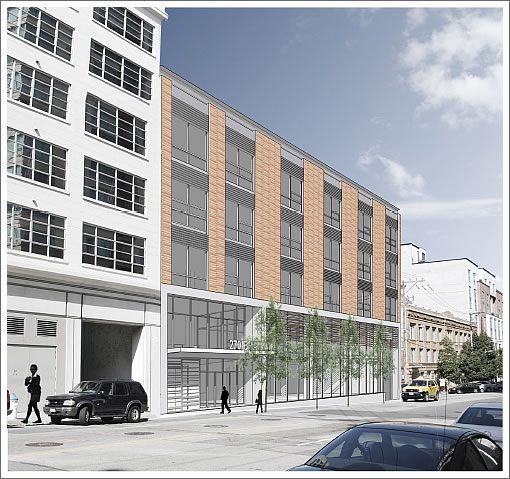
As a plugged-in reader noted when we first published the plans to build upon the 94 space parking lot at 345 Brannan Street, plans to raze the regularly filled parking lot and single-story building behind the lot at 270 Brannan on the other side of Second Street are also in the works.

As proposed, an office building rising five and seven stories high with 172,000 square feet of space and parking for 12 cars will be constructed upon the Brannan Street site between the historic Hawley and Gallo buildings.

Between the building’s five-story facade along Brannan Street and its seven story height behind, a private 5,000 square foot atrium would sit (as could the building’s tenants):

In addition to 12 parking spaces, a net loss of roughly 100 spaces for the site, the basement of the building would include parking for 33 bikes with adjacent showers and lockers.

From the Planning Department with respect to the building’s proposed design and fit within San Francisco’s South End Landmark District:
270 Brannan Street is located in a mixed character area of the landmark district with examples of older brick warehouses with deeply recessed openings and newer reinforced concrete warehouses with steel‐sash windows. The proposed project addresses this mixed character area by directly referencing the adjacent historic resources, and by incorporating similar design elements, including a high proportion of mass to void, recessed fenestration, and a vertical façade orientation.
Along Brannan Street, the façade is organized to emphasis the vertical orientation as evidenced by the alternating bays of terracotta tile and fenestration and the reinforced concrete columns on the ground floor. In addition, this street façade provides for a seven‐inch setback between aluminum‐sash windows and the terracotta cladding, thus providing for a deep shadow line along the street façade.

The proposed project is consistent and compatible with the district’s details, as evidenced by the proposed project’s façade organization and cornice articulation, which reference characteristics found within the South End Landmark District. The proposed project draws from the district’s typical warehouse façade design, as evidenced by the façade composition of base, shaft and cornice (Beaux‐Arts organization/form) and larger‐scale vehicular opening.
To reinforce the regularized tri‐partite composition, the Brannan Street façade includes a tall ground floor level with a heavy reinforced concrete belt course and three stories of alternating vertical bays of fenestration and terracotta tile capped by the simple painted metal angle cornice. The painted metal angle provides a contemporary and compatible interpretation of the district’s simple cornice lines. This façade organization references the organizational scheme of the later warehouses within the district, while still evoking the pilaster elements found within some of the district’s earlier brick warehouses.
As is common within larger district, the entryways feature additional detailing, including brick surrounds, smaller canopies and signage. The proposed project references the entryway details by providing for a simple projecting canopy, which denotes the project’s main entryway along Brannan Street.
San Francisco’s Architectural Review Committee (ARC) is slated to provide its thoughts on the building and its fit this week.
∙ Parking Lot And Development Alert: The Designs For 345 Brannan [SocketSite]
∙ San Francisco’s Historic <1 Percent And Eleven Landmark Districts [SocketSite]
As many as 1000 workers with parking for 12 cars. This is currently a managed parking lot that parks as many as 140 cars at peak hours plus a number of zip cars. Will be interesting to see where all those people park after this goes up. Also, it is full for every Home Giants game.
Oh, interesting. I work in the Gallo building. The parking lot is ugly and the proposed building looks nice.
That said, many coworkers make use of that parking lot regularly, and it has a lot more than 12 spots (which are presumably earmarked for residents of the new building). I wonder if there’s a plan to make up for the loss of parking? It’s especially going to be a problem on game days…
It’s also going to shade our building’s courtyard… bummer, but what can ya do?
@Grace – 1000 workers can fit into 172,000 square feet?
My guess is that parking in other adjacent lots will increase in price, causing some people not to drive to the area. Doesn’t seem like the end of the world.
Seven stories with a total of 172,000 square feet of office space and parking for only 12 cars? I’m sure this has to do with the city’s Transit First priorities, but before you start making everyone take the bus to work at this site, you need to improve Muni first. For such a supposedly transit-focused city, the transit system here is awful.
@anon – yes, 1,000 workers could fit. Occupant load factor for office space is 1 occupant for 100 square feet. After efficiency losses, 1,000 is quite obtainable.
I use this lot for zip cars. Projecting into the future, wonder as parking supply dwindles and the inevitable cost of parking increase, will zip car remain cost effective?
I agree completely with Heather about this development in particular, and on just about everything in general.
The more parking costs increase, the more cost effective zipcar will be, because you won’t need to pay to store your car while you’re not using it.
Of course zipcar’s costs will increase too, but those costs are shared by a lot of subscribers.
this probably explains why parking spots–nearby in fact–are going for $80k+
This is a positive addition to the neighborhood, reasonable design.
As a resident in the neighborhood who uses this Zipcar lot, I hope some of the 12 parking spots will be for Zipcar or similar.
Either way, let’s get this built!
Caltain or BART combined with the new bike share … No parking necessary.
The car-hater elite are performing a near genocidal ethnic and economic cleansing in SF. Period.
@anon – Zappos hq was designed to pack ~2,000 employees in similar space (see name link); not that I like or agree with this trend, but here it is as a cost of free delivery to my door of shoes made in asia and sold by netphone in nv.
Surface lot parking in SOMA has been going away for the past 25 years, lot by lot generally from east to west, before mostly for housing, now mostly for offices/jobs. At least 6 surface parking lots within a 5 minute walk are either being demolished or proposed to be by 5+ story buildings.
Plus the current 2nd St plan will eliminate half the parking spaces on 2nd St and two lanes of car traffic.
So, no, the lost parking spaces will not be resupplied, and yes the cost to park will rise. And all of this is according to plan as it is.
Because San Francisco wants to increase density without
I work in a similar sized building with similar amounts of parking, it was built in the 30s, somehow we all manage to get to work.
Maybe it won’t be the end of the world if about 100 parking spots are converted into a building for business and work.
just fyi: the zoning allows them to build more parking. About 40 spaces by my count. The developer knows that parking is not the most economically efficient use of valuable real estate, esp. for an office building. The market has spoken. Lots of people have historically driven to SoMa because there has been plentiful and affordable parking. When it is less plentiful and less affordable, less people will drive. It’s as simple as that. This isn’t San Ramon. This is downtown San Francisco. Developers aren’t stupid.
^The lack of faith in the market is endemic in SF. Everyone wants the government to dictate exactly what they want (in this case – “More parking!”)
When did the residents of San Francisco vote on a plan for more density, less green space and The elimination of parking lots? I don’t recall ever seeing a master development plan presented to the people for their input. Yet the city is aggressively driving devlopment as we get weekly announcements of high rises, entertainment arenas, boulevards, $10 an hour parking and buildings on our water. The city leaders have put it’s residents in a position where they are forced to “react” development by development – bacause they have seen no master plan. I strongly question whether there is one.
Huh? Now you want me to vote on every single development that gets proposed? I thought this was a representative democracy where we elected leaders to handle these things?
Just because you were not paying attention doesn’t mean there is not a general (ie ‘master’) plan and also specific plans for various neighborhoods. Perhaps you should have made your opinion known when first the Eastern SOMA plan was created.
http://www.sf-planning.org/ftp/General_Plan/index.htm
Good lord, there are high-rises and boulevards being built? In a city!?
This is shocking news, and must be stopped immediately!
@Grace: There are no shortage of places with less density and more parking lots. They’re called suburbs. Plenty to choose from!
@Grace – in every election that we’ve ever had. That’s why it’s called “representative government” – as citizens we don’t approve every plan, but allow representatives to do this stuff for us and vote them in/out depending on the job done.
Okay, so I guess I hit a nerve with you all. I was just asking for a strategy and resident input. Portland Ore is an example of a city with a master plan that they are executing well. The result was an amazing public transit system that was in place before all of the parking lots were taken.
And has been pointed out, there is a master plan, with a number of more detailed sub plans for different neighborhoods.
Portland has done some fine things, but it’s a pretty terrible comparison, IMO. Around the time that Portland was starting to plan the MAX, SF was building BART. BART is certainly superior to the MAX. Bus transit in Portland is pretty lousy, just as Muni is.
In every metric except possibly “things just seem nicer”, the Bay Area’s transit blows the Portland metro’s transit out of the water. Much, much higher frequency (especially in the burbs), etc.
Portland has done a great job with bike infrastructure though – far better than us, though we’re still in the top 10%ish, I’d say, of US metros.
Nice building. Like.
But another poster has a point: first fix Muni before razing all the options for those workers who have no better option than driving.